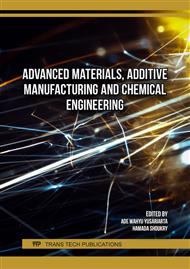[1]
Z. Jia, S. Cunha, J. Aguiar, Study on phase change materials integration in concrete: Form-stable PCM and direct addition, Process Safety and Environmental Protection 189 (2024) 1293–1302.
DOI: 10.1016/J.PSEP.2024.07.012
Google Scholar
[2]
A.M. Zeyad, M. Shubaili, N.B. Frahat, A.H. Khan, I.S. Agwa, Evaluation of sustainable lightweight concrete incorporating popcorn and pumice aggregates with sugarcane leaf ash, Sustain Chem Pharm 45 (2025) 101975.
DOI: 10.1016/J.SCP.2025.101975
Google Scholar
[3]
S. Ni, N. Zhu, Y. Hou, Z. Zhang, Research on indoor thermal comfort and energy consumption of zero energy wooden structure buildings in severe cold zone, Journal of Building Engineering 67 (2023).
DOI: 10.1016/j.jobe.2023.105965
Google Scholar
[4]
L. Xiao, L.L. Qin, S.Y. Wu, Proposal and application of comprehensive thermal comfort evaluation model in heating seasons for buildings with solar Trombe wall, Appl Therm Eng 213 (2022).
DOI: 10.1016/j.applthermaleng.2022.118774
Google Scholar
[5]
W. Wu, H.M. Skye, Net-zero nation: HVAC and PV systems for residential net-zero energy buildings across the United States, Energy Convers Manag 177 (2018).
DOI: 10.1016/j.enconman.2018.09.084
Google Scholar
[6]
R.C. (Qualitative Group), Rationalization of electrical energy consumption (Objectives, responsibilities, and actions), Egyptian Ministry of Electricity & Energy, Egypt, 2013.
Google Scholar
[7]
A.M. Heniegal, O.M. Omar Ibrahim, N.B. Frahat, M. Amin, New techniques for the energy saving of sustainable buildings by using phase change materials, Journal of Building Engineering 41 (2021).
DOI: 10.1016/j.jobe.2021.102418
Google Scholar
[8]
N. Bassim Frahat, M. Amin, A. Mohamed Heniegal, O. Mohamed Omar Ibrahim, Optimizing microencapsulated PCM ratios of sustainable cement mortar for energy savings in buildings, Constr Build Mater 391 (2023) 131844. https://doi.org/10.1016/J.CONBUILDMAT. 2023.131844.
DOI: 10.1016/j.conbuildmat.2023.131844
Google Scholar
[9]
N.B. Frahat, A. Ustaoglu, O. Gencel, A. Sarı, G. Hekimoğlu, A. Yaras, J.J. del Coz Díaz, Fuel, cost, energy efficiency and CO2 emission performance of PCM integrated wood fiber composite phase change material at different climates, Sci Rep 13 (2023) 7714.
DOI: 10.1038/s41598-023-34616-8
Google Scholar
[10]
M.T. Plytaria, E. Bellos, C. Tzivanidis, K.A. Antonopoulos, Numerical simulation of a solar cooling system with and without phase change materials in radiant walls of a building, Energy Convers Manag 188 (2019) 40–53.
DOI: 10.1016/j.enconman.2019.03.042
Google Scholar
[11]
X. Wang, H. Yu, L. Li, M. Zhao, Experimental assessment on the use of phase change materials (PCMs)-bricks in the exterior wall of a full-scale room, Energy Convers Manag 120 (2016).
DOI: 10.1016/j.enconman.2016.04.065
Google Scholar
[12]
N. Xie, X. Gao, Y. Zhong, R. Ye, S. Chen, L. Ding, T. Zhong, Enhanced thermal performance of Na2HPO4·12H2O composite phase change material supported by sepiolite fiber for floor radiant heating system, Journal of Building Engineering 56 (2022).
DOI: 10.1016/j.jobe.2022.104747
Google Scholar
[13]
B. Liu, S. Wang, W. Jia, H. Ying, Z. Lu, Z. Hong, The Effect of RHA as a Supplementary Cementitious Material on the Performance of PCM Aggregate Concrete, Buildings 14 (2024) 2150.
DOI: 10.3390/buildings14072150
Google Scholar
[14]
ECP 203-2017, Egyptian Code of Practice for Concrete Structures, Cairo – Egypt: Housing and Building Research Center (2017).
Google Scholar
[15]
ASTM C33/C33M-18, Standard Specification for Concrete Aggregates, ASTM International, West Conshohocken (2020).
Google Scholar
[16]
Egyptian Standard, Specification ES 4756-1/2013, Cairo – Egypt Hous. Build. Res. Cent (2013).
Google Scholar
[17]
ASTM International, Astm C 150, ASTM C 150/ C150M-15 Standard Specification for Portland Cement i (2019).
Google Scholar
[18]
A.M. Heniegal, O. Mohamed, O. Ibrahim, N. Bassim Frahat, M. Amin, Preparation of microencapsulated PCMs for energy-saving and thermal comfort of buildings, n.d.
DOI: 10.1016/j.conbuildmat.2023.131844
Google Scholar
[19]
BS EN 12350-2:2009, BS EN 12350-2:2009 Testing fresh concrete — Part 2: Slump test, BSI Standards Publication (2009).
Google Scholar
[20]
ASTM International, ASTM C642-21. Standard Test Method for Density, Absorption, and Voids in Hardened Concrete, 2021.
Google Scholar
[21]
BS EN 12390-3:2019, BS EN 12390-3:2019 - Testing hardened concrete Compressive strength of test specimens, British Standard Institution (2019).
Google Scholar
[22]
American Society for Testing and Materials, ASTM C 518-17 : Standard Test Method for Steady-State Thermal Transmission Properties by Means of the Heat Flow Meter Apparatus, 2017.
DOI: 10.1520/c0518-98
Google Scholar
[23]
A.M. Heniegal, O.M.O. Ibrahim, N.B. Frahat, M. Amin, Thermal and Mechanical Properties of Mortar Incorporated with Phase Change Materials (PCMs), Key Eng Mater 921 (2022) 259–269.
DOI: 10.4028/p-f0qyby
Google Scholar
[24]
M.M. Alsaadawi, M. Amin, A.M. Tahwia, Thermal, mechanical and microstructural properties of sustainable concrete incorporating Phase change materials, Constr Build Mater 356 (2022).
DOI: 10.1016/j.conbuildmat.2022.129300
Google Scholar
[25]
A. Sari, A. Karaipekli, Preparation, thermal properties and thermal reliability of capric acid/expanded perlite composite for thermal energy storage, Mater Chem Phys 109 (2008).
DOI: 10.1016/j.matchemphys.2007.12.016
Google Scholar
[26]
A. Karaipekli, A. Sari, Development and thermal performance of pumice/organic PCM/gypsum composite plasters for thermal energy storage in buildings, Solar Energy Materials and Solar Cells 149 (2016).
DOI: 10.1016/j.solmat.2015.12.034
Google Scholar
[27]
L. Erlbeck, P. Schreiner, K. Schlachter, P. Dörnhofer, F. Fasel, F. Methner, M. Rädle, Adjustment of thermal behavior by changing the shape of PCM inclusions in concrete blocks, Energy Convers Manag 158 (2018) 256–265.
DOI: 10.1016/j.enconman.2017.12.073
Google Scholar


